|
|
|
|
|
Oil On
Canvas, Real Flavor of Old Masters
|
|

|
ARTWORKS
INDEX
A B C D E F G H I J K L M N O P Q R S T U V W X Y Z |
ARTISTS
INDEX
A B C D E F G H I J K L M N O P Q R S T U V W X Y Z |
|
|
| | |
|
|
 |
BEYEREN, Abraham van -- Click Here
|
|
Dutch Baroque Era Painter, ca.1620-1690
Dutch painter. He painted seascapes as well as fruit, flower, fish, game and banquet still-lifes. He almost always signed these works with his monogram AVB, but he dated only a few. This, together with the fact that he painted diverse subjects simultaneously and his style changed little, makes it difficult to establish a chronology. He became a master in The Hague in 1640 and was related by marriage to the fish painter Pieter de Putter (before 1600-59). Van Beyeren lived in Delft from 1657 to 1661 and was again in The Hague between 1663 and 1669. |
|
 |
Bernard van orley -- Click Here
|
|
Flemish Northern Renaissance Painter , c.1488-1551
|
|
 |
Bernaert Van Orley -- Click Here
|
|
Flemish Northern Renaissance Painter, ca.1488-1541, Painter and tapestry designer, son of Valentin van Orley. He was one of the greatest proponents of ROMANISM, a northern style based on the ideals of the Italian Renaissance. It must have been in Brussels, however, that he saw the Italian works of art that influenced him so profoundly, for it seems unlikely that he ever travelled to Italy. Brussels was then world-renowned as the centre for tapestry manufacture but was suffering from the ecliptic rise of Antwerp as the pre-eminent painting centre. The artist made the best of both situations, establishing himself as a leading designer for the Brussels tapestry industry and as a master in the Antwerp Guild of St Luke by 1517. |
|
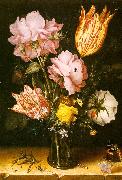 |
Berghe, Christoffel van den -- Click Here
|
|
Dutch, approx. 1590-1645 |
|
 |
Benjamin Vautier -- Click Here
|
|
painted Kinder beim Mittagessen in 1857 |
|
 |
Bartolomeo Vivarini -- Click Here
|
|
Venice ca 1432-after 1491 |
|
 |
BARTOLOMEO VENETO -- Click Here
|
|
Italian Painter, ca.1470-1531
Italian painter. He worked in Venice, the Veneto and Lombardy in the early decades of the 16th century. Knowledge of him is based largely on the signatures, dates and inscriptions on his works. His early paintings are small devotional pictures; later he became a fashionable portraitist. His earliest dated painting, a Virgin and Child (1502; Venice, priv. col., see Berenson, i, pl. 537), is signed 'Bartolomeo half-Venetian and half-Cremonese'. The inscription probably refers to his parentage, but it also suggests the eclectic nature of his development. This painting is clearly dependent on similar works by Giovanni Bellini and his workshop, but in a slightly later Virgin and Child (1505; Bergamo, Gal. Accad. Cararra) the sharp modelling of the Virgin's headdress and the insistent linear accents in the landscape indicate Bartolomeo's early divergence from Giovanni's depiction of light and space. An inscription on his Virgin and Child of 1510 (Milan, Ercolani Col.) states that he was a pupil of Gentile Bellini, an assertion supported by the tightness and flatness of his early style. The influence of Giovanni is still apparent in the composition of the Circumcision (1506; Paris, Louvre), although the persistent stress on surface patterns and the linear treatment of drapery and outline is closer to Gentile. Bartolomeo's experience as a painter at the Este court in Ferrara (1505-8) probably encouraged the decorative emphasis of his style. In the half-length Portrait of a Man (c. 1510; Cambridge, Fitzwilliam) the flattened form of the fashionably dressed sitter is picked out against a deep red curtain so that the impression of material richness extends across the entire picture surface. |
|
 |
Bartholomeus van der Helst -- Click Here
|
|
1613-1670
Dutch
Bartholomeus Van Der Helst Galleries
Dutch painter. He was the son of a Haarlem inn-keeper and presumably undertook part or all of his training in Amsterdam. His earliest works suggest that the painter Nicolaes Eliasz. Pickenoy was his master. Although van der Helst had probably already established himself as an independent master by the time he married Anna du Pire in Amsterdam in 1636, his earliest known work, a portrait of The Regents of the Walloon Orphanage, Amsterdam (Amsterdam, Maison Descartes), dates from 1637. Stylistically it is close to the work of Pickenoy. His portrait of a Protestant Minister of 1638 (Rotterdam, Boymans-van Beuningen) reveals the influence of Rembrandt. The young artist must have risen rapidly to fame in Amsterdam, for as early as 1639 he received the prestigious commission for a large painting for the Kloveniersdoelen (Arquebusiers or Musketeers Hall): The Civic Guard Company of Capt. Roelof Bicker and Lt Jan Michielsz. Blaeuw (Amsterdam, Rijksmus.), which formed part of the same series as Rembrandt Night Watch (Amsterdam, Rijksmus.). Van der Helst may not have completed this commission until 1642 or 1643. The ingenious arrangement of the figures in a broad composition shows the artist special talent for composing large groups. Pickenoy influence is less noticeable here than in the portrait of 1637; the self-assured poses of the individual figures were to become a characteristic feature of van der Helst work. The successful execution of this portrait established van der Helst reputation: from 1642, when he began to receive an increasing number of commissions for individual portraits, until 1670 he was the leading portrait painter of the ruling class in Amsterdam. From 1642 his technique in portrait painting gradually became more fluent and the rendering of costume materials more detailed. Some typical portraits of his earlier period are those of Andries Bicker (Amsterdam, Rijksmus.), his wife Catharina Gansneb Tengnagel (Dresden, Gemeldegal. Alte Meister) and their son Gerard Bicker (Amsterdam, Rijksmus.), all of 1642, and the Portrait of a Young Girl (1645; London, N.G.). In 1648 van der Helst painted a second civic guard portrait, The Celebration of the Peace of M?nster at the Crossbowmen Headquarters, Amsterdam (Amsterdam, Rijksmus.), a superbly composed and well painted portrait that, until the late 19th century, was considered one of the masterpieces of the Golden Age but later lost popularity because of its smooth and modish execution. It can nevertheless still be regarded as one of the most important group portraits of the 17th century. Its technical perfection, characterized by a well-modelled rendering of the figures and a smooth handling of the brush, dominated the rest of van der Helst oeuvre. |
|
 |
Bartholomeus van Bassen -- Click Here
|
|
(1590 - 1652) was a Dutch Golden Age painter and architect.
Van Bassen was born in Antwerp. Little is known of his early life, but according to the RKD he became a member of the Delft Guild of St. Luke in 1613. In 1622 he moved to the Hague, where he became a member of the The Hague Guild of St. Luke two years later and where he became dean in 1627 and headman in 1636 and 1640. He is known for his architectural works, sometimes with staffage by the painters Anthonie Palamedesz, Esaias van de Velde, and Jan Martszen de Jonge. |
|
 |
Balthasar van der Ast -- Click Here
|
|
(1593/94 - 1657) was a Dutch Golden Age painter who specialized in still lifes of flowers and fruit, as well as painting a number of remarkable shell still lifes; he is considered to be a pioneer in the genre of shell painting. His still lifes often contain insects and lizards. He was born in Middelburg and died at Delft.
|
|
 |
Balen, Hendrick von -- Click Here
|
|
Dutch, approx. 1575-1632
Hendrik van Balen
Students included Anthony Van Dyck, Frans Snyders and Gerard Seghers
|
|
 |
BALEN, Hendrick van -- Click Here
|
|
Dutch Baroque Era Painter, ca.1575-1632
Hendrik van Balen (1575 - 1632) was a Flemish painter, who was born and died in Antwerp. Van Balen studied art while traveling in Italy. He was the teacher of Anthony Van Dyck and Frans Snyders and was also a contemporary of many of the other famous Flemish artists, such as the Brueghels, Jan and Peter. |
|
 |
BAILLY, David -- Click Here
|
|
Dutch Baroque Era Painter, 1584-1657
Dutch painter and draughtsman. The son of a Flemish immigrant who was a calligrapher and fencing-master, Bailly was apprenticed to a local surgeon-painter and then to Cornelius van der Voort (1576-1624), a portrait painter in Amsterdam. In the winter of 1608 he started out as a journeyman, spending a year in Hamburg and then travelling through several German cities to Venice and Rome. On the return voyage he visited several courts in Germany, working for local princes, including the Duke of Brunswick-Wolfenb?ttel. While no works survive from the immediate period following his return to the Netherlands in 1613, descriptions in old sale catalogues suggest that he may have produced history paintings in the manner of his contemporaries Pieter Lastman and the Pynas brothers. |
|
 |
BABUREN, Dirck van -- Click Here
|
|
Dutch Baroque Era Painter, 1595-1624
1624). Dutch painter. His father, Jasper van Baburen (d ?1599), had been in the service of Geertruijd van Bronckhorst van Battenburg, Baroness (vrijvrouw) of Vianen, Viscountess (burggravin) of Utrecht, and thus Dirck must have received a better than average education, a fact at least partially confirmed by the innovative and often literary nature of his subject-matter. In 1611 he is recorded as a pupil of the portrait and history painter Paulus Moreelse in Utrecht. It is likely that this was the last year of his apprenticeship. Van Baburen probably left for Italy shortly after 1611, for a document rediscovered in the late 1980s records a signed and dated altarpiece of the Martyrdom of St Sebastian (1615; untraced), executed for a church in Parma. His most important pictures made in Italy were painted in collaboration with David de Haen (d 1622) for the Piet? Chapel of S Pietro in Montorio, Rome, which was decorated between 1615 and 1620. Van Baburen's paintings for the chapel were mentioned by Giulio Mancini in his manuscript notes, Considerazioni sulla pittura (c. 1619-20); there Mancini claims the artist was 22 or 23 years old when he carried out the commission. One of his best-known works, the Entombment (formerly dated 1617), is still in situ on the altar of the chapel. This much-copied composition reveals van Baburen's close study of Caravaggio's famous Entombment (Rome, Pin. Vaticana). In 1619 and the spring of 1620 van Baburen and de Haen were recorded as living in the same house in the Roman parish of S Andrea delle Fratte. Caravaggio's close follower and presumed student, Bartolomeo Manfredi, was living in the same parish in 1619. Van Baburen must have known the works of Manfredi. |
|
 |
August Xaver Karl von Pettenkofen -- Click Here
|
|
painted Zigeunerkinder in 1855 |
|
 |
AST, Balthasar van der -- Click Here
|
|
Dutch Baroque Era Painter, ca.1593-1656
1657). Dutch painter. He was the brother-in-law of Ambrosius Bosschaert (i), whose household he entered in 1609, after the death of his father. He remained as Bosschaert's pupil, until he was 21. In 1615 van der Ast moved with the Bosschaert family to Bergen-op-Zoom. However, a year later the Bosschaerts were living in Utrecht, but van der Ast is not recorded there until 1619, when he was entered as a master in the Guild of St Luke. He remained in Utrecht until 1632, then lived in Delft, where he enrolled in the painters' guild on 22 June 1632. On 26 February 1633 he married Margrieta Jans van Bueren in Delft, where he spent the rest of his career; the marriage produced two children. |
|
 |
Ary de Vois -- Click Here
|
|
was a Dutch Golden Age painter.
Ary de Vois was the son of Alewijn de Vois from Utrecht, who was organist in the Pieterskerk, Leiden, in 1635. Ary became a pupil in Utrecht of Nikolaus Knepfer, who also taught Jan Steen. Ary then returned to Leiden to study with Abraham van den Tempel, who lived there between 1648 and 1660. De Vois joined the Leiden Guild of St Luke on 16 October 1653, paying dues until 1677. He was dean in 1662-64, headman in 1664-65 and dean again from 1667-68. He married Maria van der Vecht, on 5 February 1656.
According to Houbraken his marriage caused a lull in his production, especially when he moved to Warmond where he took up fishing as a hobby. He had to move back to Leiden in order to keep his production levels high
|
|
 |
Armand-Vincent de Montpetit -- Click Here
|
|
painted Louis XV King of France and Navarre in 1774 |
|
 |
Antonio Viladomat y Manalt -- Click Here
|
|
Spanish, 1678-1755,Spanish Catalan painter. He was the most significant figure in Catalan painting from the end of the 17th century to the first half of the 18th. He trained with P. B. Savall and J. B. Perram?n in Barcelona. The arrival of the Archduke Charles (later Charles VI) of Austria in Barcelona in 1703 as a pretender to the throne during the War of the Spanish Succession (1702-13), accompanied by such Italian artists as Ferdinando Galli-Bibiena, acquainted Viladomat y Manalt with artistic trends in Italy. He experienced problems with the artists' guild in Barcelona because of his refusal to participate in the traditional work system. Despite this, his workshop-academy became a centre for the training of numerous painters, sculptors and engravers. Viladomat y Manalt was principally a religious painter, and his oil paintings include Christ Appearing to St Ignatius of Loyola (c. 1711-20; Barcelona, Jesuit Convent) and St Augustine and the Holy Family (Madrid, Prado). He also painted such murals as the tempera Angels with the Sudarium (c. 1727; Matare, S Mar?a, Capilla de los Dolores), but most of the others have disappeared. He painted an extensive series of monastic and evangelical works, in which his revival of compositions characteristic of the Spanish Golden Age is apparent. Examples include the Stigmatization of St Francis (c. 1724; Barcelona, Mus. A. Catalunya), part of a cycle of paintings on the life of St Francis commissioned for the cloister of the convent of S Francisco de As?s in Barcelona. His late Baroque style is related to the severe and realistic trend in Spanish painting in the early 17th century. Some interesting profane allegories by the artist are extant, notably the series Four Seasons (c. 1720-30; Barcelona, Mus. A. Catalunya), which consists of landscapes with genre scenes. Several of the still-lifes by Viladomat y Manalt such as the realistic Still-life with Dead Turkey (Barcelona, Mus. A. Catalunya), which has strong contrasts of light, bear an affinity with Neapolitan painting of the last decades of the 17th century. |
|
 |
Antonio Vaz -- Click Here
|
|
painted A Virgem com o Menino in 1540 |
|
 |
Antonio Maria Vassallo -- Click Here
|
|
Italian Baroque Era Painter, ca.1620-1670 |
|
 |
Anton von Werner -- Click Here
|
|
Germany (1843- 1915 ) - Painter |
|
|
|
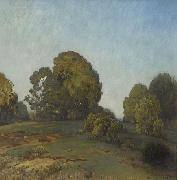 |
Anton Ritter von Stadler -- Click Here
|
|
painting Landschaft in 1909 |
|
 |
Antoine Vollon -- Click Here
|
|
(April 23, 1833 - August 27, 1900) was a French realist artist, best known as a painter of still lifes, landscapes and figures. During his lifetime, Vollon was a successful celebrity, enjoyed an excellent reputation, and was called a "painter's painter". |
|
 |
Antoine Vestier -- Click Here
|
|
(1740 - 1824) was a French miniaturist and painter of portraits, born at Avallon in Burgundy, who trained in the atelier of Jean-Baptiste Pierre. He showed his work at the Salon de la Correspondance, Paris, before being admitted to the Academie Royale de Peinture et de Sculpture in 1785, when a portrait of the painter Gabriel-François Doyen, pwas his morceau de reception.
Among his sitters was the royal beniste, Jean-Henri Riesener (1786, Musee de Versailles).
|
|
 |
Anthony Vandyck Copley Fielding -- Click Here
|
|
English
1787-1855 |
|
 |
Anthony Van Dyck -- Click Here
|
|
Dutch
1599-1641
Anthony Van Dyck Locations
Flemish painter and draughtsman, active also in Italy and England. He was the leading Flemish painter after Rubens in the first half of the 17th century and in the 18th century was often considered no less than his match. A number of van Dyck studies in oil of characterful heads were included in Rubens estate inventory in 1640, where they were distinguished neither in quality nor in purpose from those stocked by the older master. Although frustrated as a designer of tapestry and, with an almost solitary exception, as a deviser of palatial decoration, van Dyck succeeded brilliantly as an etcher. He was also skilled at organizing reproductive engravers in Antwerp to publish his works, in particular The Iconography (c. 1632-44), comprising scores of contemporary etched and engraved portraits, eventually numbering 100, by which election he revived the Renaissance tradition of promoting images of uomini illustri. His fame as a portrait painter in the cities of the southern Netherlands, as well as in London, Genoa, Rome and Palermo, has never been outshone; and from at least the early 18th century his full-length portraits were especially prized in Genoese, British and Flemish houses, where they were appreciated as much for their own sake as for the identities and families of the sitters. |
|
 |
anthonis van dyck -- Click Here
|
|
Flemish painter and draughtsman, active also in Italy and England. He was the leading Flemish painter after Rubens in the first half of the 17th century and in the 18th century was often considered no less than his match. A number of van Dyck's studies in oil of characterful heads were included in Rubens's estate inventory in 1640, where they were distinguished neither in quality nor in purpose from those stocked by the older master. Although frustrated as a designer of tapestry and, with an almost solitary exception, as a deviser of palatial decoration, van Dyck succeeded brilliantly as an etcher. He was also skilled at organizing reproductive engravers in Antwerp to publish his works, in particular The Iconography (c. 1632-44), comprising scores of contemporary etched and engraved portraits, eventually numbering 100, by which election he revived the Renaissance tradition of promoting images of uomini illustri. His fame as a portrait painter in the cities of the southern Netherlands, as well as in London, Genoa, Rome and Palermo, has never been outshone; and from at least the early 18th century his full-length portraits were especially prized in Genoese, British and Flemish houses, where they were appreciated as much for their own sake as for the identities and families of the sitters.
|
|
 |
Anthonie van Montfoort -- Click Here
|
|
(Montfoort, 1533 or 1534 - Utrecht, 1583) was a Dutch painter
His father was a mayor of Montfoort. He went to learn under Hendrick Sweersz. in Delft and Frans Floris in Antwerp. In 1552 he returned to Montfoort, where he married the daughter of the then mayor.
Blocklandt then settled in Delft, where he produced paintings for the Oude Kerk and the Nieuwe Kerk, later lost to the beeldenstorm. Also he painted a work for the Janskerk (Gouda) called De onthoofding van Saint-Jacob, now in the museum there.
In 1572, Blocklandt made a trip to Italy, after which he settled for good in Utrecht, joining a guild there in 1577. In 1579, he painted his best known work, the triptych The Assumption of Mary that is now in the Basilica of St. Martin in Bingen am Rhein.
According to Carel van Mander, Blocklandt painted biblical scenes, mythological subjects and portraits. He is early-Mannerist in style and he and Joos de Beer (another pupil of Floris) were responsible for the Mannerist style begun by Utrecht artists around 1590. Van Mander wrote that De Beer had many paintings by Blocklandt in his workshop that his pupil Abraham Bloemaert later copied. Few works can definitely be attributed to him. One of these is "Joseph interpreting Pharaoh's dream", now in the Centraal Museum in Utrecht.
He was also the teacher of the Delft portrait painter Michiel Jansz van Mierevelt.
|
|
 |
Anthonie van Borssom -- Click Here
|
|
(January 2, 1631, Amsterdam - march 19, 1677, Amsterdam), was a Dutch Golden Age landscape painter.
According to the RKD he was an Italianate landscape painter who copied works of popular landscape painters of his day in Amsterdam such as Jacob van Ruisdael, Paulus Potter, Aelbert Cuyp (church interieurs), Nicolaes Berchem, Philips Koninck, Jan Wijnants, Aert van der Neer (moonlit landscapes), and Cornelis Vroom. He lived and worked in Amsterdam but made a trip in 1650-1655 along the Rhine and spent time in Kleve.He was buried in the Westerkerk. |
|
 |
Anselm van Hulle -- Click Here
|
|
painted Anna Margareta Wrangel, countess of Salmis in 1648 |
|
 |
Anne Vallayer-Coster -- Click Here
|
|
French Rococo Era Painter, 1744-1818,was an eighteenth-century French painter. Known as a prodigy artist at a young age, she achieved fame and recognition very early in her career, being admitted to the Royal Academy in 1770, at the age of twenty-six.
Despite the negative reputation that still-life painting had at this time, Vallayer-Coster??s highly developed skills, especially in the depiction of flowers, soon generated a great deal of attention from collectors and other artists. Her precocious talent and the rave reviews?? earned her the attention of the court, where Marie Antoinette took a particular interest in Vallayer-Coster's paintings.
Regardless of her closeness to the ancient regime and France's hated monarch she survived the bloodshed of the French Revolution. However, the fall of the French monarchy, which were her primary patrons, caused her banishment into the shadows.
Anne Vallayer-Coster was a woman in a man??s world. It is unknown what she thought of contemporaries who admitted her to the confraternity, and made her an honorary ??man??. Her life was determinedly private, dignified and hard-working. Occasionally she attempted other genres, but for the usual reasons her success at figure painting was limited
|
|
 |
Andries van Eertvelt -- Click Here
|
|
1590-1652
Flemish
Andries van Eertvelt Location
Flemish painter. He enrolled as a member of Antwerp Guild of St Luke in 1609. In 1615 he married Catherine Vlieger (d 1627), after whose death he went to Genoa, where he worked for Cornelis de Wael. By c. 1630 he was back in Antwerp, where he had his portrait painted by Anthony van Dyck (1632; Augsburg, Schaezlerpal.). In 1633 Eertvelt married Elisabeth Boots, probably a daughter of the Antwerp painter Jan Boots (b before 1620). Eertvelt is regarded as the first Flemish marine painter. Over the years his palette and style changed. His first paintings, mostly of ships in storms (e.g. Sea Battle in a Storm; Schwerin, Staatl. Mus.), were painted in greenish-black and brown tones, often using white to highlight the rigging against the dark sea. After his tour of Italy he favoured views of southern harbours, with calm seas painted in soft tones (e.g. Spanish Ships Leaving a Port; Vienna, Ksthist. Mus.). In his day Eertvelt was a man of distinction whose artistic qualities were praised by the poet Cornelis de Bie and whose marine paintings were appreciated abroad, some being exported as far as Seville and Lisbon. His pupils included Gaspard van Eyck (1613-73), Hendrik Minderhout (1632-96) and Matthieu van Plattenberg. |
|
 |
Andrea Vanni -- Click Here
|
|
Italian Byzantine Style Painter , ca.1332-1414
was an Italian painter of the early Renaissance. He was born in Siena, and in conjunction with Bartolo di Maestro Fredi, began to paint in 1353. He seems to have been important in Siena, having been elected a member of the Great Council in 1370, Gonfaloniero in 1371, sent as Envoy to the Pope at Avignon in 1372, on a mission to Florence in 1373, and again as Envoy to the Pope at Naples in 1384. Many examples exist of his paintings between 1353 and 1414 in Naples and its vicinity. At the chapel of St. Catherine of Siena, in the church of San Domenico, Naples, can be found the remains of a fresco painted by him to commemorate the life of that saint, who was a correspondent and perhaps a relation of his own. A letter from St. Catherine to Vanni survives. About the year 1400, |
|
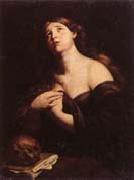 |
Andrea Vaccaro -- Click Here
|
|
Italian Baroque Era Painter, 1604-1670
He first studied literature but at an early age turned to painting. He was probably a pupil of the late-Mannerist painter Gerolamo Imparato, though there are no known works from this period. About 1620 he became a follower of Caravaggio; he copied Caravaggio's Flagellation (Naples, Capodimonte), and his copy and the original hung in S Domenico Maggiore, Naples (copy in situ). David with the Head of Goliath (Florence, Fond. Longhi) and Sebastian (Naples, Capodimonte) are early works indebted to Caravaggio's naturalism and chiaroscuro. After 1630 Vaccaro drew inspiration from Guido Reni, Anthony van Dyck and Pietro Novelli and made copies of their works for Neapolitan collectors and dealers such as Gaspar Roomer and Jan Vandeneyden. |
|
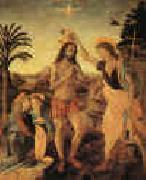 |
Andrea della Verrocchio -- Click Here
|
|
1435-1488
Italian Andrea della Verrocchio Gallery |
|
 |
Andrea del Verrocchio -- Click Here
|
|
Italian Early Renaissance Sculptor, ca.1435-1488
Florentine sculptor and painter, whose real name was Andrea di Michele di Francesco di Cioni. He was a leading figure in the early Renaissance, and his workshop was a center for the training of young artists in Florence. A virtuoso metalworker, Verrocchio was primarily concerned with the spirited rendering of movement and the elaboration of detail. Many of his paintings are lost. Of the remaining panels, his hand is evident in the Baptism of Christ (Uffizi), assisted by Leonardo da Vinci. In the Pistoia altarpiece he was aided by Lorenzo di Credi. Other attributions are Tobias and the Angel (National Gall., London), two paintings of the Madonna and Child (National Gall., London; Berlin), and a Crucifixion with Saints (Argiano). Most of Verrocchio's achievements in sculpture have survived. His earlier work includes the bold group Incredulity of St. Thomas (Orsanmichele). In 1472 he designed the tombs of Piero and Giovanni de' Medici (San Lorenzo). In the same period he created the graceful Boy with a Dolphin and a lithe portrayal of David (Bargello). He went to Venice (c.1480) to work on the equestrian monument of the condottiere Bartolomeo Colleoni. |
|
 |
ALSLOOT, Denis van -- Click Here
|
|
Flemish painter (b. 1570, Mechlin, d. 1628, Bruxelles)
He initially painted using the style of Gillis van Coninxloo, but after 1610 gradually developed a style of his own. This style can be seen in paintings such as The feast of the Ommegang (Museo del Prado, Madrid) and Procession to Mary at the Zavel in Brussels (Victoria and Albert Museum, London).
At the beginning of the 17th century, in either 1600 or 1606, his career rose when he served as court painter to Albert and Isabella.
Hendrick de Clerck painted sometimes the people in his works.
Van Alsloot's work can be regarded as a precursor to modern Landscape art. |
|
 |
Alonso Vazquez -- Click Here
|
|
Spanish
?-1608
was a Spanish sculptor and painter of the Renaissance period. Vazquez was born in Ronda, and learned painting in the school of Arfian at Seville. He passed through the usual apprenticeship of painting "sargas" and at length painted frescoes and oil-pictures. For the Cathedral and the convents of St. Francis and St. Paul, he painted a variety of works, no longer extant. He painted a series of canvases on the life of St. Raymond, for the cloister of the friars of the order of Mercy. Vazquez was one of the artists chosen by the city of Seville to paint the great catafalque erected in the Cathedral, at the time of public mourning for the death of Philip II. He died either in Seville or in Mexico, |
|
 |
Alois Auer von Welsbach -- Click Here
|
|
Wels1813-1869 Vienna |
|
 |
allart van everdingen -- Click Here
|
|
Allaert van Everdingen (bapt. 18 June 1621 Alkmaar - buried 8 November 1675, Amsterdam), was a Dutch Golden Age painter and printmaker in etching and mezzotint.
Van Everdingen was the son of a government clerk at Alkmaar. He and his older brothers, the painters Jan and Caesar van Everdingen, according to Arnold Houbraken, were taught by Roelandt Savery at Utrecht. Allaert moved in 1645 to Haarlem, where he studied under Pieter de Molijn, and finally settled about 1657 at Amsterdam, where he died in 1675. |
|
|
|
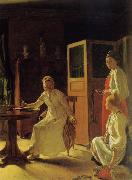 |
Alexey Gavrilovich Venetsianov -- Click Here
|
|
painted Morning of the land-lady in 1823 |
|
 |
Alexej von Jawlensky -- Click Here
|
|
Alexej Georgewitsch von Jawlensky (13 March 1864 - 15 March 1941) was a Russian expressionist painter active in Germany. He was a key member of the New Munich Artist's Association (Neue Kenstlervereinigung Menchen), Der Blaue Reiter (The Blue Rider) group and later the Die Blaue Vier (The Blue Four).
|
|
|
|
|
|
 |
Alexander von Wagner -- Click Here
|
|
German/Hungarian, 1838-1919 |
|
 |
Alexander von Humboldt -- Click Here
|
|
Berlin 1769-1859 Berlin,was a German naturalist and explorer, and the younger brother of the Prussian minister, philosopher, and linguist Wilhelm von Humboldt (1767-1835). Humboldt's quantitative work on botanical geography was foundational to the field of biogeography. Between 1799 and 1804, Humboldt travelled to Latin America, exploring and describing it from a scientific point of view for the first time. His description of the journey was written up and published in an enormous set of volumes over 21 years. He was one of the first to propose that the lands bordering the Atlantic were once joined (South America and Africa in particular). Later, his five-volume work Kosmos (1845) attempted to unify the various branches of scientific knowledge. |
|
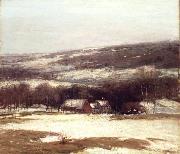 |
Alexander Theobald Van Laer -- Click Here
|
|
Alexander Theobald Van Laer (1857-1920) was an American painter, born at Auburn, New York.
He studied at the Art Students League of New York |
|
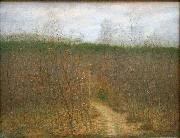 |
Albijn Van den Abeele -- Click Here
|
|
painted Coppice at Sint-Martens-Latem in 1898 |
|
 |
Albert von Keller -- Click Here
|
|
Albert von Keller (April 27, 1844 - July 14, 1920) was a German painter.
He was born at Gais, in Switzerland; he studied at the Munich Academy under Lenbach and Ramberg, and must be counted among the leading colorists of the modern German school. Travels in Italy, France, England and Holland, and a prolonged sojourn in Paris, helped to develop his style. His scenes of society life, such as the famous "Dinner" (1890), are painted with thoroughly Parisian esprit, and his portraits are marked by the same elegant distinction. He was particularly successful in the rendering of rustling silk and satin dresses and draperies. His historical and imaginative works were as modern in spirit and as unacademical as his portraits. As of 1911, at the Munich Pinakothek was his painting "Jairi Töchterlein" (1886), while the Königsberg Museum contained his "Roman Bath", and the Liebieg collection in Reichenberg the "Audience with Louis XV", the first picture that drew attention to his talent. Among other important works he painted "Faustina in the Temple of Juno at Praeneste", "The Witches Sleep" (1888), "The Judgment of Paris", "The Happy Sister", "Temptation" (1892), "Autumn" (1893), "An Adventure" (1896), and "The Crucifixion". |
|
 |
Albert van Ouwater -- Click Here
|
|
Albert van Ouwater (c. 1410/1415-1475) was one of the earliest artists of Early Netherlandish painting working in the Northern Netherlands, as opposed to Flanders in the South of the region.
[edit] BiographyHe was probably born in Oudewater, and is mentioned by Karel van Mander (1604) as a reputable painter at the time in which he lived.[1] According to Karel van Mander he was possibly a contemporary of Jan van Eyck and had been the teacher of Geertgen tot Sint Jans, though he was quick to qualify this statement with the eye-witness account of an old man named Albert Simonsz who had been a pupil of Jan Mostaert and claimed neither he nor Mostaert had ever even heard of this Albert van Ouwater or Geertgen tot Sint Jans.[1] Van Mander highly commends an altarpiece by Van Ouwater in the principal church in Haarlem, the Grotekerk or Sint-Bavokerk, representing St. Peter and St. Paul, in which the figures are carefully and correctly designed, and richly coloured.[1] Van Mander posits Van Ouwater as the founder of the Haarlem school of painting, making him the first major Dutch (as opposed to Flemish) artist. According to Van Mander, landscape painting was a particular specialty of this Dutch school, although none of Van Ouwater's surviving works exhibit this tendency. Van Ouwater seems to have been a contemporary of Dirk Bouts in mid-15th-century Haarlem, and Geertgen tot Sint Jans may have been his pupil. |
|
 |
Albert van der Eeckhout -- Click Here
|
|
Dutch, born circa 1610-1666 |
|
 |
Aert van der Neer -- Click Here
|
|
1603-1677
Dutch
Although generally known by the name of Aert, he usually signed himself Aernout. According to Houbraken, van der Neer spent his youth in Arkel near Gorinchem (Gorkum), a town on the river Waal, east of Dordrecht, where he worked as a majoor (steward) for the lords of Arkel. He became an amateur painter, possibly as a result of his contact with the Camphuyzen brothers Rafael Govertsz. (1597/8-1657) and Jochem Govertsz. (1601/2-59). Aert married Lysbeth Govertsdr (Liedtke) who was almost certainly Rafael and Jochem sister. Rafael acted as witness at the baptism of their daughter Cornelia in 1642. Around 1632 van der Neer and his wife moved to Amsterdam where, in about 1634, their eldest son, Eglon, was born. |
|
 |
Aelst, Willem van -- Click Here
|
|
Dutch Baroque Era Painter, 1627-ca.1683 Studied under Otto Marseus van Schrieck. Students included Rachel Ruysch. Specializes in Still Life. was a Dutch artist who specialized in still-life painting with flowers or game. Van Aelst was born to a family of prominent city magistrates. He learned to paint from his uncle, the still-life painter Evert van Aelst. On 9 November 1643 he enrolled as a master of the Guild of Saint Luke at Delft. Between 1645 and 1649 he lived in France. In 1649 Van Aelst travelled to Florence, where he served as court painter to Ferdinand II de Medici, grand duke of Tuscany. At this time, the grand duke also employed two fellow Dutchmen Matthias Withoos and Otto Marseus van Schrieck, the latter also a still-life painter who probably influenced Van Aelst's style. In 1656 he returned to the Netherlands to settle permanently in Amsterdam. He became one of the most prominent still-life painters of his generation, |
|
 |
Adrian Vanson -- Click Here
|
|
Adrian Vanson (died c. 1602) was court portrait painter to James VI of Scotland.
Adrian succeeded Arnold Bronckorst as court painter in Scotland in May 1584, and his appointment was subsequently confirmed by royal letter on 20 August 1584. Adrian Vanson was paid £8-10s in June 1581 for two pictures sent to Theodore Beza. A letter by James VI's former tutor Peter Young accompanied pictures of John Knox and George Buchanan sent to Geneva in November 1579 for the woodcuts in Beza's Icones (1580). The Scottish portraits arrived too late for the book, and the woodcuts of Knox and a James VI, thought to be by Vanson, were first published in Simon Goulart's edition of the Icones in 1581. The picture of George Buchanan, which was never published in Beza's Icones, but may have appeared in other later works, is attributed to Bronckorst.
Knox from Beza's Icones,
after Adrian VansonVanson also painted ceremonial spears and banners for the coronation of Anne of Denmark. When he was made a burgess of Edinburgh, it was hoped he would teach his craft to apprentices. He may have been 'Lord Seton's painter', who was recorded drawing portraits for coins at the mint in Edinburgh. There was a un-named Flemish painter working on the king's portrait at Stirling Castle in May 1579. This may have been Vanson or Bronckorst. According to the inventories of the Earl of Leicester, he had a portrait of the 'young king of Scots' in 1580, which may have been another copy of this picture. Leicester sent his own portrait to James VI, painted on canvas by Hubbard in 1583.
Attributed portraits include James VI; Anne of Denmark; Patrick Lyon, Lord Glamis; Sir Thomas Kennedy of Culzean; Agnes Douglas, Countess of Argyll. Vanson's James VI of circa 1585 survives at Edinburgh castle. In May 1586 a French ambassador in Scotland, the Baron d'Esneval, promised to get Mary, Queen of Scots a copy of a recent portrait of James VI from the only painter in Edinburgh. There had been rumours of an embassy to Denmark to discuss the king's marriage in April 1586. It is thought the picture at Edinburgh Castle was made by Vanson for this embassy or a similar purpose. |
|
 |
Adriaen Van Utrecht -- Click Here
|
|
Flemish Baroque Era Painter, 1599-1652
Flemish painter. He was apprenticed to Herman de Ryt in 1614 and later visited France, Italy and Germany before returning to Antwerp by 1625. He painted pantry scenes, farmyards with poultry, fish markets, game pieces, garlands and diverse still-lifes of fruit and vegetables. Game paintings are most frequent and reflect the influence of Frans Snyders. Adriaen adopted the same abundant displays of game, fruit and vegetables, usually set on a table parallel to the picture plane. Compositions typically fall in horizontal and vertical lines in contrast to the dynamic diagonals of Snyders. In large works, such as the Still-life with Game, Vegetables, Fruit and a Cockatoo (1650; Malibu, CA, Getty Mus.), Adriaen's accessories overflow the table on to the floor below. Baroque devices, such as a sweeping curtain and background window view, add movement and depth. Van Utrecht favoured warm earthen tones, especially grey-green, and a strong chiaroscuro light in his still-lifes; the latter may derive from his knowledge of Italian painting. The artist's style changed little during his career, save for the gradual elimination of figures in his paintings. The influence of Jan de Heem and Jan Fyt can also be seen in his later work. |
|
 |
Adriaen van ostade -- Click Here
|
|
Dutch Baroque Era Painter, 1610-1685
Painter, draughtsman and etcher. According to Houbraken's rather unreliable biography, he was a pupil concurrently with Adriaen Brouwer of Frans Hals in Haarlem. Hals influenced him very little, whereas Brouwer, who was described as 'known far and wide' as early as 1627, had a decisive influence on the evolution of Adriaen van Ostade's always idiosyncratic portrayal of peasant life. The first documentary mention of Adriaen van Ostade as a painter is in 1632 (Schnackenburg, 1970). Most of his paintings are signed and dated, the earliest firmly dated example being the Peasants Playing Cards |
|
 |
Adriaen Van Diest -- Click Here
|
|
was born at the Hague in 1655. He was the son of Jeronymus van Diest, a painter of sea-pieces, by whom he was instructed in the art. When he was seventeen years of age he came to London, and was employed by Granville, Earl of Bath, for whom he painted several views and ruins in the west of England. He also painted portraits, but did not meet with much encouragement, although his pictures, particularly his landscapes, possess considerable merit; as a proof of which Horace Walpole states that there were seven pictures by Van Diest in Sir Peter Lely's collection. He etched several landscapes from his own designs, in a slight, masterly style. Van Diest died in London in 1704. Unfortunately for his reputation, he is generally known by his worst pictures, which are frequently found in old houses, on wainscots, or over doors, and are executed in a hasty manner, with much mountainous background. His better pictures have changed their name.
|
|
 |
Adriaen van der werff -- Click Here
|
|
Dutch Baroque Era Painter, 1659-1722
Dutch painter and draughtsman. He was apprenticed to the portrait painter Cornelis Picolet (1626-79) from 1668 to 1670 and then from c.1671 to 1676 to Eglon van der Neer in Rotterdam. From 1676 van der Werff produced small portraits and genre paintings as an independent master; the Cook and Hunter at a Window (1678; New York, priv. col.; see Gaethgens, no. 2) and Man and Woman Seated at a Table (1678; St Petersburg, Hermitage) perpetuate the thematic and stylistic traditions of Gerrit Dou, Gabriel Metsu, Frans van Mieris and Gerard ter Borch (ii) but are distinguished by their greater elegance and richness of costume and interior. Van der Werff's portraits date mainly from the years 1680-95 (e.g. Two Children with a Guinea-pig and a Kitten (1681; London, Buckingham Pal., Royal Col.)). The motif of children with animals recalls van der Neer, while the careful depiction of fabrics recalls the Leiden school of 'Fine' painters. His Portrait of a Man in a Quilted Gown (1685; London, N.G.) resembles compositions by Caspar Netscher and Nicolaes Maes: a figure leaning against a balustrade, before a landscape. Van der Werff's work is, however, more elegant, in part because of the depiction of fabrics |
|
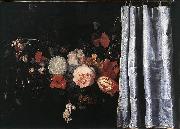 |
Adriaen van der Spelt -- Click Here
|
|
Adriaen van der Spelt (ca. 1630, Leiden - 1673, Gouda), was a Dutch Golden Age flower painter.
According to Houbraken, whose comments were based on the Gouda stories by Ignatius Walvis, he was an excellent flower painter born in Leiden, but his parentage was from Gouda. He spent many years at the court of Brandenburg working for Frederick William I, Elector of Brandenburg, but moved to Gouda to marry a third time with a nasty wife from Groningen who drove him to his grave.
According to the RKD he was a flower painter who spent the years 1664-1670 at the court of Brandenburg. |
|
 |
Adriaen van de Venne -- Click Here
|
|
Delft 1589-The Hague 1662
Dutch painter, draughtsman and poet. De Bie's account (1661) is the only known source on van de Venne's youth and training. He was born of 'worthy' parents who had fled to Delft from the southern Netherlands to escape war and religious strife. Inspired by his early study of Latin to become an illustrator, he was partly self-taught but also received instruction in painting and illumination from the otherwise unrecorded Leiden goldsmith and painter Simon de Valck. His second teacher, Hieronymus van Diest, |
|
 |
Adriaen van de Velde -- Click Here
|
|
(bapt. 30 November 1636, Amsterdam - bur. 21 January 1672, Amsterdam), was a Dutch animal and landscape painter, son of Willem van de Velde the Elder and brother of Willem van de Velde the Younger, the marine painter.
Adriaen did not want to become a marine painter so he was trained in the studio of Jan Wynants, the landscape painter. There he made the acquaintance of Philip Wouwerman, who is believed to have aided him in his studies of animals, and to have exercised a powerful and beneficial influence upon his art. Having made exceptionally rapid progress, he was soon employed by his master to introduce figures into his landscape compositions, and he rendered a similar service to Hobbema, Ruysdael, Verboom and other contemporary artists. According to Houbraken, he died while in collaboration with Jan van der Heyden and Frederik de Moucheron, painting animals on their paintings.[1]
His favourite subjects were scenes of open pasture land, with sheep, cattle and goats, which he executed with dexterity, with much precision of touch and truth of draughtsmanship, and with clear silvery colouring. He painted a few small winter scenes with skaters, and several religious subjects, such as the Descent from the Cross, for a Roman Catholic hidden church in Amsterdam.
In addition to his paintings, of which nearly two hundred have been catalogued, he executed about twenty etchings, several of which appear from their dates to have been done in his fourteenth year. They are distinguished by directness of method and by delicacy and certainty of touch. Van de Velde lived in Kalverstraat, near the Regulierspoort.
|
|
 |
Adriaen Pietersz Vande Venne -- Click Here
|
|
Dutch
1589-1662
|
|
 |
Adolph von Menzel -- Click Here
|
|
1815-1905
German
Adolph von Menzel Gallery
His father was the headmaster of a school for girls, and intended to educate his son as a professor; but he would not thwart his taste for art. Left an orphan in 1832, Menzel had to maintain his family. In 1833 Sachse of Berlin published his first work, an album of pen-and-ink drawings reproduced on stone, to illustrate Goethe's little poem, Kunstlers Erdenwallen. He executed lithographs in the same manner to illustrate Denkw??rdigkeiten aus der brandenburgisch-preussischen Geschichte; The Five Senses and The Prayer, as well as diplomas for various corporations and societies.
From 1839 to 1842 he produced 400 drawings, largely introducing to Germany the technique of wood engraving, to illustrate the Geschichte Friedrichs des Grossen (History of Frederick the Great) by Franz Kugler. He subsequently brought out Friedrichs der Grossen Armee in ihrer Uniformirung (The Uniforms of the Army under Frederick the Great), Soldaten Friedrichs der Grossen (The Soldiers of Frederick the Great); and finally, by order of the king Frederick William IV, he illustrated the works of Frederick the Great, Illustrationen zu den Werken Friedricks des Grossen (1843-1849).
By these works Menzel established his claim to be considered one of the first, if not actually the first, of the illustrators of his day in his own line.
Pencil drawing by Menzel, 1891.Meanwhile Menzel had set himself to study unaided the art of painting, and he soon produced a great number and variety of pictures, always showing keen observation and honest workmanship in subjects dealing with the life and achievements of Frederick the Great, and scenes of everyday life, such as In the Tuileries, The Ball Supper, and At Confession. Among the most important of these works are The Forge (1875) and The Market-place at Verona. Invited to paint The Coronation of William I at Koenigsberg, he produced an exact representation of the ceremony without regard to the traditions of official painting.
In Germany he received many honors, and was the first painter to be given the Order of the Black Eagle in 1898 which included a title of nobility, becoming von Menzel. |
|
 |
Adolph Friedrich Vollmer -- Click Here
|
|
(17 December 1806 - 12 February 1875) was a German landscape and marine painter and graphic artist. He and his contemporary, the painter Christian Morgenstern, were pioneers in Hamburg of early Realism in painting.
As son of a bookkeeper to a Hamburg merchant, Vollmer grew up in humble circumstances.[3] Determined to become a painter against the wishes of his father,[4] he became an apprentice to the brothers Suhr who owned a graphic workshop producing panorama prints. For one and a half years Vollmer travelled throughout Germany with one of the brothers, Cornelius Suhr, as had been Morgenstern before him. In 1826 he was introduced by the Hamburg art-dealer Ernst Harzen to the wealthy aristocrat and supporter of the arts, Carl Friedrich von Rumohr, who was patron to many young Hamburg artists among them Morgenstern and Otto Speckter. Probably on Rumohr advice Vollmer completed his studies under Christoffer Wilhelm Eckersberg at the Royal Danish Academy of Fine Arts in Copenhagen. He then moved to Munich from where he undertook journeys to Lake Konstanz, to the Austrian and Swiss Alps, to Venice, to Le Havre and to the Netherlands.
In 1839 Vollmer returned to Hamburg and settled there. One of his sons, Johannes Vollmer, became a prominent architect of protestant churches; a grand-son was the art historian and encyclopaedist Hans Vollmer who, for many years, edited the Thieme-Becker Kenstler Lexikon.
Vollmer became blind in 1866.
|
|
 |
Adolf Von Meckel -- Click Here
|
|
German, 1856 - 1893 |
|
 |
Adolf von Hildebrand -- Click Here
|
|
1847 Marburg-1921 Munich, He was a sculptor, the son of Marburg economics professor Bruno Hildebrand. He was the author of Das Problem der Form in der Bildenden Kunst ("The Problem of Form in Painting and Sculpture"). From 1873 he lived in Florence in San Francesco, a secularized sixteenth-century monastery. In 1877 he married Irene Schäuffelen. He spent significant time in Munich after 1889 executing a monumental fountain there, the Wittelsbacher Brunnen. He is known for five monumental urban fountains. He was ennobled by the King of Bavaria in 1904, He was the father of the painter Eva, Elizabeth, sculptor Irene Georgii-Hildebrand, Sylvie, Bertele, and Catholic theologian Dietrich von Hildebrand. |
|
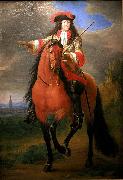 |
Adam Frans van der Meulen -- Click Here
|
|
painted Louis XIV before Strasbourg in 1682 |
|
 |
Adalbert John Volck -- Click Here
|
|
Adalbert J. Volck (1828 - 1912) was a dentist, political cartoonist, and caricaturist born in Bavaria. He was known for supporting the Confederacy during the American Civil War, doing so through his political cartoons (below), smuggling items for the Confederate army, and personally assisting President Jefferson Davis by acting as a courier.
Volck was also known for his work on porcelain restoration techniques in dentistry. |
|
 |
Abraham van Strij -- Click Here
|
|
painted Een kersenverkoopster aan de deur
in 1816 |
|
 |
Abraham van der Hecken -- Click Here
|
|
Dutch Baroque Era Painter, active 1635-1655 |
|
 |
Abraham van den Tempel -- Click Here
|
|
(1622?C1672) was a Dutch Golden Age painter.
He probably learned painting from his father, also a painter, but who died when he was still quite young, in 1636. That is the same year that he moved to Amsterdam, where he stayed until 1647, whereupon he moved to Leiden. According to Houbraken he was the son of a Mennonite preacher in Leeuwarden who was a respected art teacher. His father was Lambert Jacobsz (or Jacobszoon), who had taught Govert Flinck and Jacob Adriaensz Backer in their youth, both of whom were artists from Mennonite families. Abraham took the name Tempel because when he studied in Leiden, he lived in a house there with a relief of a Tempel in the keystone. He became a pupil of Jacob Backer, and studied mathematics at Leiden University. He met with great success with the Leiden city council, earning several generous commissions, including a series of three large allegorical paintings on the cloth industry of Leiden for the Cloth Hall which still hang in their original place today in the Stedelijk Museum De Lakenhal.
Sir William Davidson of Curriehill, Conservator of the Cloth Staple at Veere (with his son Charles), 1664.He became master of the Guild of St. Luke in 1657 and in 1659 he was chartermaster. In 1660 he returned to Amsterdam. His pupils were Frans van Mieris the Elder, Carel de Moor, Michiel van Musscher, Ary de Vois, and Isaac Paling
|
|
 |
Abraham van Beijeren -- Click Here
|
|
(ca. 1620 - March 1690) was a Dutch Baroque era painter. He was little regarded in his day but is now considered one of the greatest of still-life painters. Van Beijeren (alternatively spelled "Beyeren") lived in a succession of Dutch towns. Born in The Hague, the artist also lived in Delft, Amsterdam, Alkmaar and Gouda. In 1678 he settled in Rotterdam, where he died in 1690.
|
|
 |
Abraham Jansz Van Diepenbeeck -- Click Here
|
|
1596-1675, Flemish glass-painter, draughtsman, painter and tapestry designer. His reputation rests primarily on his drawings and oil sketches, of which several hundred survive, intended mainly as designs for stained-glass windows and prints. He was strongly influenced by the work of other important Flemish artists of the late 16th century and early 17th, notably Rubens, whose motifs and stylistic elements he frequently reworked in his own compositions. |
|
 |
Abraham Hendrickz van Beyeren -- Click Here
|
|
1621-1690
Dutch
Abraham Hendrickz van Beyeren Location |
|
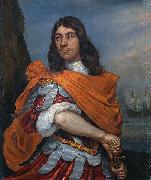 |
Abraham Evertsz. van Westerveld -- Click Here
|
|
painted Cornelis Tromp in Roman costume in 1650-1692 |
|
 |
AACHEN, Hans von -- Click Here
|
|
German Mannerist Painter, 1552-1615
(b Cologne, 1552; d Prague, 4 March 1615). German painter and draughtsman, active also in Italy and Bohemia. One of the foremost painters of the circle gathered at the Prague court of Emperor Rudolf II. |
|
 |
Virgilio Guidi -- Click Here
|
|
1891-1928
Virgilio Guidi Gallery |
|
|
|
|
| | |
|
|
|
|